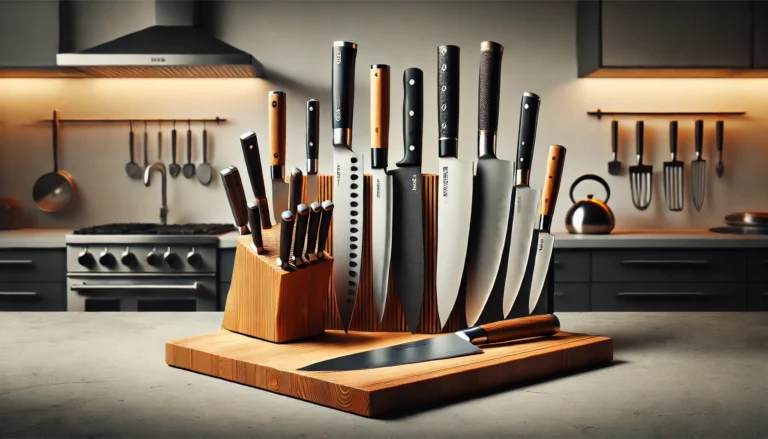
There’s something magical about the aroma of onions sizzling in a pan. If you’re a home cook or a food blogger, you know that onions are the backbone of countless recipes. But slicing them can be a tearful chore if you don’t know what knife to use to cut onions. This comprehensive guide will walk you through everything you need to choose the perfect knife for cutting onions, making your culinary adventures smooth and enjoyable. You’ll discover various knives and their specific features, and by the end, you’ll know which is your best kitchen companion.
What Knife to Use to Cut Onions? (Short Answer)
A chef’s knife is the best choice for cutting onions. It provides a good balance of size and control. The broad blade allows for effortless slicing through the layers without much effort. A sharp blade will make your cuts clean and reduce tears. Make sure to keep your knife well-maintained for the best results.
The Importance of the Right Knife
Using the right knife for cutting onions is crucial. It affects not only the ease of slicing but also the texture and flavor of your onions. A dull or inappropriate knife can crush the onion cells, releasing more enzymes that cause tears and a sharper taste. Conversely, a sharp blade makes clean cuts, preserving the onion’s integrity and reducing eye irritation.
Why Onions Require Special Attention
Onions have multiple layers and a slippery surface, making them difficult to handle. The right knife can make all the difference in ensuring even, thin slices without losing control. Understanding these characteristics can help you understand why the right knife is essential.
Chef’s Knife The All-Rounder
A chef’s knife is a versatile tool in any kitchen. Its broad blade and sharp edge make it perfect for slicing onions. Its design allows for a rocking motion, making it easier to achieve uniform cuts. A chef’s knife is wise if you invest in just one knife.
Santoku Knife Precision and Balance
Another excellent option is the Santoku knife, which originates from Japan. Known for its precision and balance, it’s designed for slicing, dicing, and mincing. The flat edge provides more contact with the cutting board, making it ideal for cutting onions without much effort.
Paring Knife For Small Jobs
While not typically used for slicing large onions, a paring knife is handy for smaller tasks. If you’re dealing with shallots or pearl onions, this small knife provides the control needed for intricate cuts. It’s also helpful in peeling onions before slicing them with a larger blade.
Serrated Knife Why It’s Not Ideal
You might wonder if a serrated knife could work for onions. While great for bread and tomatoes, a serrated knife can make a mess of onions. The saw-like motion can crush the layers, leading to uneven cuts and more tears.
The Role of Blade Material
The blade material plays a significant role in the knife’s performance. Stainless steel is durable and resistant to rust, making it a popular choice. High-carbon steel, though prone to rust, offers exceptional sharpness and edge retention. Choose a material that fits your maintenance routine and performance needs.
Handle Comfort and Control
The knife’s handle is just as important as the blade. A comfortable, ergonomic handle ensures better control and reduces hand fatigue. For the best grip, look for wood, plastic, or composite handles.
The Importance of Knife Maintenance
Even the best knife needs proper maintenance to perform well. Regular sharpening and honing keep the blade in top condition. Cleaning your knife promptly after use and storing it properly extends its lifespan.
Cutting Techniques for Onions
Using the correct technique can make cutting onions easier and safer. Cut the onion half from root to tip, then peel off the skin. Make horizontal and vertical cuts, then slice through for perfect diced onions. Mastering this technique can elevate your cooking game.
Safety Tips for Cutting Onions
Safety is paramount in the kitchen. Always keep your knife sharp; a dull knife is more dangerous as it requires more force, increasing the risk of slipping. Use a stable cutting board, and always keep your fingers tucked in, using your knuckles to guide the knife.
Popular Brands to Consider
Several reputable brands offer high-quality knives. Wüsthof, Shun, and Victorinox are known for their durable and sharp blades. Investing in a good brand ensures your knife will serve you well for years.
How to Choose the Right Knife for You
Choosing the right knife depends on your personal preferences and needs. Consider the types of meals you prepare most often and your comfort with different knife styles. Visit a store to hold various knives and see which feels best.
Conclusion:
Cutting onions is easy if you have the right knife. A chef’s knife is the best choice for most home cooks, and a Santoku knife is an excellent option for easy slicing and dicing. Remember, comfort and maintenance are crucial to making your knife last. With the right knife and proper care, you can enjoy cooking with onions without tears.
FAQs
A chef’s knife is recommended because it has a broad, sharp blade that makes slicing through onions easier and more controlled. This reduces the effort needed and minimizes tears.
While a paring knife is ideal for small tasks and peeling, it is unsuitable for cutting large onions. Its small blade must provide more control or surface area for efficient slicing.
A serrated knife can crush the onion layers instead of slicing them cleanly, leading to uneven cuts and more tears. It is better suited for bread and tomatoes.
Stainless steel is a good choice due to its durability and rust resistance. High-carbon steel offers better sharpness and edge retention but requires more maintenance to prevent rust.
Regular sharpening and honing, cleaning the knife promptly after use, and storing it correctly are crucial to maintaining its performance. A well-maintained knife will make cutting onions easier and safer.






